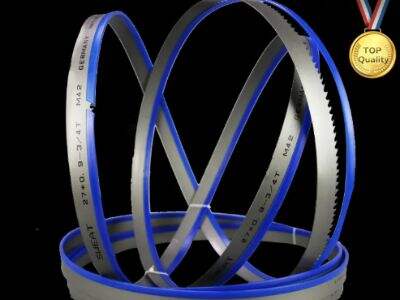A bi-metal bandsaw blade is an important part of the process whether you are cutting alloy or hardened steels. SWEAT know just how critical choosing the right bimetal bandsaw blades for metal for your application can be, which is why in this guide we have done an overview of what bi-metal bandsaw blades are available.
Why Selecting the Right Bi Metal Bandsaw Blade is Essential?
Bi-metal bandsaw blades consist of two different types of steel that are welded in order to produce a cutting tool that is strong and long-lasting. The blade has a flexible steel body to stand up to cutting heavy materials and teeth made of hard steel for durability, retaining sharpness for long.
How to Choose an Ideal Bandsaw Blade for Alloy Steels?
Alloy Steels: A high tooth count bi-metal bandsaw blade with variable tooth spacing is a necessary investment for cutting alloy steels. This will help keep your cut smooth and clean while keeping too much stress off the blade. Also, don't forget to think about how thick the material is that you will be cutting, since this determines what width and teeth per inch (TPI) the blade should be.
Getting around the bi-metal bandsaw blade choices for hard-to-machining steels
Alloy steels and the super-hardened steels need a high tooth count bi-metal bandsaw blade with the correct variable pitch (VP) similar to that of cutting tough alloy steels. However, the harden material also means that you will need a blade which has a high blade speed and feed rate so that it can still be sharp. Make sure you use bimetal bandsaw blades specifically made for cutting hard steels so that you can get the best out of your saw.
Tips for choosing the right bandsaw blade for longer life
To increase the life of your bi-metal bandsaw blade, it is important to select the appropriate blade for the job and install and tension it correctly. It is crucial to perform basic maintenance such as cleaning and lubricating the edge since this can significantly enhance its longevity as well. Do not push the blade too hard or cut materials that you know are too abrasive for it and this can wear a break prematurely.
What will change is the other key aspects of choosing a bi-metal bandsaw blade for cutting hard materials?
Bi-Metal Bandsaw Blades for Tough Cutting Applications Like Alloy and Hardened Steels: To select a bi-metal bandsaw blade for cutting demands of alloy, or hardened steels to be cut, consider the tooth count and pitch in addition to a speed of the bandsaw (or some say blade speed), feed rate (and material thickness). In addition, it is imperative to go with a blade from a respected manufacturer such as SWEAT to back up the quality and reliability. Taking the time to choose the best bandsaw blade for the task at hand will pay dividends in cutting performance, downtime and long term savings.
For clean cuts which preserve the lifespan of your blade and increase overall cutting performance, making sure you choose the appropriate bi-metal bandsaw blade to cut alloy and hardened steels is a must! With the above key considerations in mind, and by following these tips, you can safely navigate the bi-metal bandsaw blade landscape to pick out the best blade for your application. Choose SWEAT for your every bi metal bandsaw blade requirement and see the difference quality and precision does in cutting.
Table of Contents
- Why Selecting the Right Bi Metal Bandsaw Blade is Essential?
- How to Choose an Ideal Bandsaw Blade for Alloy Steels?
- Getting around the bi-metal bandsaw blade choices for hard-to-machining steels
- Tips for choosing the right bandsaw blade for longer life
- What will change is the other key aspects of choosing a bi-metal bandsaw blade for cutting hard materials?


